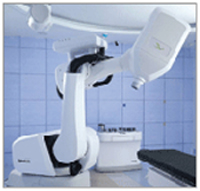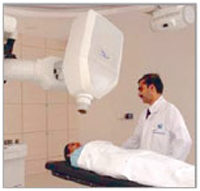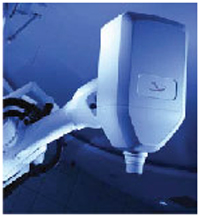Cyber Knifet surgery India offers information on Cyber Knife in India, Cyber Knife surgery cost India, Cyber Knife surgery hospital in India, Delhi, Mumbai, Chennai, Hyderabad & Bangalore, Cyber Knife surgery in India
The CyberKnife® is a state-of-the-art, radiotherapy equipment for robotic radiosurgery that allows radiation oncologists to treat pathologies painlessly, without the need for an operation.
 CyberKnife® uses pencil beams of radiation which can be directed at any part of the body, from any direction with the help of a robotic arm. The system tracks the tumour's position, detects any movement of the tumour or patient, and automatically corrects radiation delivery.It then targets the tumour with multiple beams of high-energy radiation, destroying abnormal tissue without damaging surrounding areas.
CyberKnife® uses pencil beams of radiation which can be directed at any part of the body, from any direction with the help of a robotic arm. The system tracks the tumour's position, detects any movement of the tumour or patient, and automatically corrects radiation delivery.It then targets the tumour with multiple beams of high-energy radiation, destroying abnormal tissue without damaging surrounding areas.
The treatment is so accurate that it's now possible to treat tumours previously thought to be inoperable and untreatable. Although the results of treatment do not always show immediately, in most cases, the procedure will initially stop the growth of tumours, before gradually reducing their size.
As there is no open surgery, the risk complications normally associated with an operation are eliminated, as is the need for a long recovery time. This makes treatment suitable even for those who are not well enough to cope with surgery. Most patients leave the hospital the same day.
How CyberKnife® works
CyberKnife® gives patients new hopes for treatment of tumours previously labeled as inoperable or untreatable. As mentioned earlier, the CyberKnife® uses pencil beams of radiation, that can be directed at any part of the body from any direction, via a robotic arm. The vast array of different angles/trajectories from which pencil beams of radiation converge upon the tumour lead to a high cumulative dose of radiation at the convergence point (the target/tumour), and yet a very fast 'fall-off' of dose towards the periphery of the carefully mapped target. The surrounding normal tissues/organs only receive a small fraction of the high dose to the target.
 Whilst the tumour may be destroyed by an efficiently high dose of Cyberknife radiation conventional radiotherapy cannot usually do the same without exposing the surrounding organs leaving behind side effects. CyberKnife® often overcomes this problem by its capability to reach the target area with pinpoint accuracy.
Whilst the tumour may be destroyed by an efficiently high dose of Cyberknife radiation conventional radiotherapy cannot usually do the same without exposing the surrounding organs leaving behind side effects. CyberKnife® often overcomes this problem by its capability to reach the target area with pinpoint accuracy.
CyberKnife® system consists of an advanced lightweight linear accelerator (LINAC) - this device is used to produce high energy ‘pencil’ beams of radiation.
There is a robot, that can make the linear accelerator point from a wide variety of angles. It’s movements are under the control of a central computer. This centralized computer controlled movement of the system that’s also called as the ’Brain’ of the machine
A pair of X-ray cameras are able to obtain frequent pictures of the patient during the treatment session. The computer uses this information to target the radiation beam with sub-millimeter accuracy.
The use of the robot in the CyberKnife® System is vital in delivering radiation beams accurately whilst movement of the patient or that of the target is closely monitored during the treatment. Any change in the position of the patient is detected by the cameras and then the robot adjusts its position accordingly to allow re-targeting of the linear accelerator before delivering the radiation beam. Use of the robot ensures that there is no need to manually reposition the patient during treatment as a result of movement, thereby slowing down the treatment process.
CyberKnife® with Synchrony
The Synchrony system is an additional, enhanced system that works along side the CyberKnife® System. According to Accuray (the manufacturer of CyberKnife®), the Synchrony system is the first technology in the world capable of delivering radiosurgery to tumours affected by the respiratory cycle. This includes tumours of the lungs, liver, kidney and pancreas.
 Synchrony uses a complex system of cameras, motion tracking software, fibre-optic sensing technology, infrared emitters and a special tight-fitting elastic patient garment. As a patient undergoes CyberKnife® treatment the synchrony system
continually identifies patient breathing movement in conjunction with the internally placed fiducial markers and then updates the treatment delivery of the radiation beams. It means that the CyberKnife® system is always able to track the tumour in real time, thus allowing maximum precision of radiation delivery and minimum risk of damage to surrounding healthy tissue.
Synchrony uses a complex system of cameras, motion tracking software, fibre-optic sensing technology, infrared emitters and a special tight-fitting elastic patient garment. As a patient undergoes CyberKnife® treatment the synchrony system
continually identifies patient breathing movement in conjunction with the internally placed fiducial markers and then updates the treatment delivery of the radiation beams. It means that the CyberKnife® system is always able to track the tumour in real time, thus allowing maximum precision of radiation delivery and minimum risk of damage to surrounding healthy tissue.
The majority of CyberKnife® centres around the world use Synchrony technology in conjunction with the CyberKnife® robot. Centres which only treat intracranial tumours do not need respiratory tracking and therefore may use CyberKnife® without the Synchrony system.
 CyberKnife® indications
CyberKnife® indications
- Lesions adjacent to radiosensitive structures
- Complex-shaped lesions
- Previously irradiated lesions precluding further external beam irradiation
- Recurrent lesions after surgery
- Lesions requiring difficult surgical approaches
- Patients who are too frail for surgery or refuse surgery
How is CyberKnife® different
Standard stereotactic radiosurgery techniques rely on a rigid frame fixed to the patient’s skull for head immobilization. There are other systems for extra-cranial Stereotactic Radiation. These systems are most often uncomfortable. If the target moves with the breathing of the patient, they often require breath holding techniques, which may be difficult for some patients. Frame-based systems mean there is a limit to the number of angles the radiation can be delivered through.
The CyberKnife® System offers maneuverability and versatility that other systems cannot offer, therefore now making it possible to treat tumours anywhere in the body,
especially the brain, spine, liver, lung, pancreas and prostate. The combination of image guidance with the help of X-ray cameras and the very latest computer technology ensures that the CyberKnife® System is able to overcome the limitations of older frame-based radiosurgery systems, such as the Gamma Knife and LINAC based X-Knife.
Conditions CyberKnife® can treat
All patients considered for radiotherapy are potential candidates for CyberKnife® also. Research is still going on what all other pathologies and conditions can be considered for CyberKnife® treatment.
Click on these links for more informations on conditions that can be effectively treated by CyberKnife®
Common conditions treatable :
 Astrocytoma, glioma, glioblastoma multiforme, oligodendroglioma :
Astrocytoma, glioma, glioblastoma multiforme, oligodendroglioma :
CyberKnife® offers superior conformance to tumour shape, which is important especially for recurrence after surgery and conventional radiotherapy. CyberKnife® can also irradiate the tumour bed to delay or prevent recurrence.
 Brain metastases :
Brain metastases :
Radiosurgery may be equal to surgery for single metastases and better for multiple metastases. Advanced imaging allows CyberKnife® to treat those that are widely dispersed.
 Spinal tumours :
Spinal tumours :
CyberKnife® is regularly used to treat spinal metastases. It may also serve as a treatment for many primary spinal tumours.
 Pituitary adenoma :
Pituitary adenoma :
CyberKnife’s® staged treatments may help to avoid or minimize the risk of visual loss and other side effects associated with single-session radiosurgery. Its superior conformance minimizes irradiation of normal tissue, including the optic chiasm and hypothalamus.
 Hemangioblastoma :
Hemangioblastoma :
CyberKnife® non-invasively treats the tumour nodule, usually in one session, even in hard-to-reach areas. This is especially beneficial for Von Hippel Lindau disease patients who can become disabled by multiple surgeries.
 Skull base tumours :
Skull base tumours :
The proximity of these tumours to vital nerve and vascular structures makes them surgically problematic.
 Chordoma :
Chordoma :
Since chordomas are relatively radioresistant and close to vital structures, they were frequently labeled as untreatable. Superior conformance and staged sessions permit higher doses therefore. CyberKnife® should be considered as a primary treatment option, the treatment of choice by now.
 Meningioma :
Meningioma :
For smaller meningiomas, radiosurgery is an ideally non-invasive therapy. CyberKnife® is especially safe for meningiomas adjacent to critical structures because it can be delivered in fractions.
 Neurofibroma & Schwannoma :
Neurofibroma & Schwannoma :
While these tumours’ resistance to radiation makes conventional radiotherapy an option only when surgery is not, CyberKnife’s® conformance makes it an effective alternative to radiation therapy and surgery for selected patients.
 Acoustic neuroma :
Acoustic neuroma :
Studies show that CyberKnife® treatment in stages offers the highest rates ever achieved for hearing and facial-nerve preservation besides effective control of the tumour-growth.
 Intracranial AVMs :
Intracranial AVMs :
With CyberKnife®, we can treat locations that can’t be safely approached with microsurgery or endovascular therapy. Selected AVMs have an 80% chance of disappearing after a single treatment session though it may take some time. CyberKnife® can also be used in conjunction with other therapies to remove remnants.
 Spinal AVMs :
Spinal AVMs :
CyberKnife® is the first and the only system to offer radiosurgical treatment of spinal AVMs .It provides the same or even more accuracy and success as for intracranial AVMs.
 Trigeminal neuralgia :
Trigeminal neuralgia :
Unlike invasive therapies and conventional radiotherapy, CyberKnife® is painless, frameless and less risky to be used in functional Neurological conditions like in Trigeminal neuralgia.
Head and Neck Cancer
Early Head & Neck cancers - As a sole modality in certain early head & neck cancer when surgery is not contemplated and long duration of conventional radio therapy is considered inconveniently time consuming. Also used as a boost to Residual disease in locally advanced head & neck cancers.
Recurrent Head & Neck cancers - CyberKnife® is increasingly being used for head and neck tumours, particularly recurrent cancers of limited size. Control of symptoms such as active bleeding or impending nerve compression is often achievable.
Every Cancer of the Nasal Fossae, or inoperable Otolaryngologic tumours where actual structures being involved is the reason why a tumour is considered unresectable or only marginally resectable might be candidates for this treatment. With significantly less irradiation of surrounding tissues, CyberKnife® can even treat tumours conventionally considered as untreatable or already treated with conventional radiotherapy.
Chest - CyberKnife® is a sole modality in early lung cancer when surgery is not contemplated and long duration of conventional radiotherapy is not convenient. CyberKnife® treatment seems to be even more successful than conventional radiotherapy.
Metastatic Lung cancer - The lungs are unfortunately a common site of secondary spread for a wide variety of primary cancers, including colorectal cancer, upper gastrointestinal cancers, kidney cancer, sarcomas (primary soft tissue or bone cancers) and pediatric cancers.
Advanced Lung cancer - The primary treatment for more advanced lung cancer patients (stage III) usually consists of chemotherapy and radiotherapy, CyberKnife® treatment may increase the disease- free survival. Research on this is still going on though.
Recurrent Disease - It is not unusual for lung cancer to relapse following attempted curative treatment. For these recurrent cancers, CyberKnife® radiosurgery offers a new treatment alternative to patients, who have traditionally had very few remaining options, and may be considered in selected patients for symptom relief, in some cases translating to additional long-term disease-free survival.
Gastrointestinal Tract
It is not unusual for these patients to relapse following attempted curative treatment. For these recurrent cancers, CyberKnife® radiosurgery offers a new treatment alternative especially to patients, who have traditionally had very few remaining options.
Liver cancer - While surgical resection remains the best treatment for operable primary liver cancer (hepatocellular carcinoma, cholangiocarcinoma), in the event of multiplicity, CyberKnife® is an option worth considering. Sparing adequate remaining liver function may be achievable with this modality of stereotactic radiosurgery, particularly in patients with some degree of cirrhosis.
Metastatic liver - If not easily resectable, are treatable with CyberKnife®
Pancreatic cancer - The CyberKnife® System has been used to treat pancreatic cancer in patients who are poor surgical candidates, those who refuse surgery and in patients for whom surgery or other treatments have failed. Two clinical studies from Stanford University have shown the growth of pancreatic tumours in patients with advanced disease has been controlled by CyberKnife® radiosurgery.
Urolog
Kidney cancer - For malignancies arising in a single kidney, radio surgery offers a non surgical treatment.
Prostate cancer - The challenge that doctors face in treating prostate tumours with radiation therapy is that the prostate moves unpredictably as air passes through the rectum and as the bladder fills. Minimizing any large movements of the prostate can help reduce unnecessary irradiation of surrounding healthy tissue.
The CyberKnife® Robotic Radiosurgery System is able to overcome this challenge by continuously identifying the exact location of the prostate tumour throughout the course of the treatment. During CyberKnife® treatment, a patient can lie still while the doctor zeroes in on a moving target – the prostate – and irradiates it without harming surrounding areas. As a result, the procedure is more comfortable for patients, radiation is delivered more accurately and treatments can be completed in one to five days.
Benefits of CyberKnife
- Patients across the world have been successfully treated with the CyberKnife System.
- Pain free
- Non-invasive
- No anesthesia required
- Outpatient procedure
- No recovery time
- Immediate return to normal activity
- No invasive head or body frame
- No breath holding during treatment



 CyberKnife® uses pencil beams of radiation which can be directed at any part of the body, from any direction with the help of a robotic arm. The system tracks the tumour's position, detects any movement of the tumour or patient, and automatically corrects radiation delivery.It then targets the tumour with multiple beams of high-energy radiation, destroying abnormal tissue without damaging surrounding areas.
CyberKnife® uses pencil beams of radiation which can be directed at any part of the body, from any direction with the help of a robotic arm. The system tracks the tumour's position, detects any movement of the tumour or patient, and automatically corrects radiation delivery.It then targets the tumour with multiple beams of high-energy radiation, destroying abnormal tissue without damaging surrounding areas.
 Whilst the tumour may be destroyed by an efficiently high dose of Cyberknife radiation conventional radiotherapy cannot usually do the same without exposing the surrounding organs leaving behind side effects. CyberKnife® often overcomes this problem by its capability to reach the target area with pinpoint accuracy.
Whilst the tumour may be destroyed by an efficiently high dose of Cyberknife radiation conventional radiotherapy cannot usually do the same without exposing the surrounding organs leaving behind side effects. CyberKnife® often overcomes this problem by its capability to reach the target area with pinpoint accuracy.
 Synchrony uses a complex system of cameras, motion tracking software, fibre-optic sensing technology, infrared emitters and a special tight-fitting elastic patient garment. As a patient undergoes CyberKnife® treatment the synchrony system
continually identifies patient breathing movement in conjunction with the internally placed fiducial markers and then updates the treatment delivery of the radiation beams. It means that the CyberKnife® system is always able to track the tumour in real time, thus allowing maximum precision of radiation delivery and minimum risk of damage to surrounding healthy tissue.
Synchrony uses a complex system of cameras, motion tracking software, fibre-optic sensing technology, infrared emitters and a special tight-fitting elastic patient garment. As a patient undergoes CyberKnife® treatment the synchrony system
continually identifies patient breathing movement in conjunction with the internally placed fiducial markers and then updates the treatment delivery of the radiation beams. It means that the CyberKnife® system is always able to track the tumour in real time, thus allowing maximum precision of radiation delivery and minimum risk of damage to surrounding healthy tissue.
